“Have you watched the recent Dior Cruise Show?” Itzel Sosa excitedly asks us as she prepares to take us on a captivating journey behind the meaning of the dresses showcased in the Dior Cruise 2024 Show.
In today’s article, Itzel delves into a subject that holds a special place in her heart — her rich cultural Mexican heritage. As she takes us behind the scenes of the show, Itzel unravels the profound meanings infused within the collection.
Join us as we explore the powerful connection between fashion and Mexican heritage through Itzel's insightful exploration.
Happy reading,
Amarissa
Have you watched the recent Dior Cruise Show? It stands out as one of the year's most culturally significant and iconic showcases.
On May 20th, Christian Dior captivated their audience with their 2024 Cruise Show, set in the mesmerizing backdrop of Mexico City's historic Antiguo Colegio de San Ildefonso. The show paid homage to the iconic Mexican artist Frida Kahlo and her artistic legacy and the rich tapestry of Mexican culture. The fashion-forward collection embraced a forward-thinking and gender-bending aesthetic and encapsulated immense meaning within the tiniest intricacies.
Let's dive deeper into the show's essence.
Mexico is a passionate country full of heart, a flourishing biodiversity made of flora & fauna, and artistic brilliance, with Frida Kahlo as the quintessential representation of the country's rich cultural heritage. Her world-renowned masterpieces seamlessly combine nature with her iconic self-portraits, depicting the intertwining of femininity and masculinity, capturing the raw realities of abortion, miscarriage, and birth, all while resoundingly proclaiming women's liberation and bodily empowerment.
As Frida's artistic genius soared to great heights, so did her influence in fashion. It is no wonder that Maria Grazia Chiuri, Dior's Creative Director, drew inspiration from Frida's style for this year's resort collection. In paying tribute to Mexican culture, Chiuri showcased multiple looks that celebrated the country's rich tapestry of flora and fauna and incorporated traditional elements such as huipiles and mariachi aesthetics.
However, Chiuri's vision extended beyond mere aesthetics. In her creative process, she found inspiration in the contemporary practices of women and underrepresented creatives in Mexico, recognizing the power they exude through their artistic mediums.
The collection drew inspiration from local skilled craftsmen and artisans from Oaxaca, Chiapas, and Puebla states, all of whom aided in creating the collection. Notably, the collection drew inspiration from feminist, activist, and artist Elina Chauvet's eye-catching art installations.
I greatly admire that Dior is pursuing authentic representation by fostering meaningful collaborations with various artisans. For this show, they collaborated with artisans from numerous regions in Mexico, including Hilan Cruz Cruz, a Nahua weaver from Puebla. Hilan and the artisans of Taller Textil Yolcentle workshop designed a few of the embroidered pieces and Puebla-styled dresses.
Through his weaving, Cruz was able to express his culture and heritage. Many may overlook how technical a simple weave can be; Cruz uses specific geometric designs and weave counts to bring his creations to life. Among the curated selection of ceremonial pieces, Dior handpicked the kexkemitl from Cruz, symbolizing the profound cultural significance woven into every thread.
In an interview with Women's Wear Daily, Hilan shed light on the prevalent issue of cultural appropriation, saying, "There are huge brands who have copied Mexican textiles without knowing the origins, how it's done, the context." This widespread replication of fashion designs from various communities underscores the importance of major brands recognizing and crediting the original sources.
Fortunately, Dior was completely transparent with the artisans from Cruz's workshop (as well as all other artisans who helped create the looks in the show) who worked together to perfect this collection. This shift in approach is increasingly crucial to honor and respect the creativity and cultural heritage of these marginalized communities that have often been overlooked.
Pedro Meza, a weaver in Chiapas, also contributed to this beautiful collection. His craft is based on the heritage of Mayan culture, and with the help of his workshop Sna Jolobil, a Gaban square tunic and tote was created.
Under Nancy Areli Morales' guidance, Rocinante, a women's group in Oaxaca, embarked on a collective embroidery project. Paying homage to Mexico's abundant flora and fauna, they crafted vibrant geometric patterns within their dresses. Through their artistry, these women send a powerful message to the world that despite being part of a small community, their presence and contributions are undeniably significant.
Together they created a pattern that adorned a Dior Bar jacket and skirt.
In these particular designs, the beauty of Mexican culture shines through, captivating audiences with its vibrant colors. This look embodies the dedication and heartfelt effort poured into the intricate process of handcrafting the embroidery. It shows that Mexican culture cannot and should not be overlooked and that traditional practices can be fused to create something new and beautiful.
Shifting the focus to the jewelry pieces, which of course, is what pulls a look together, their significance in this particular show cannot be overlooked. In line with Dior's vision for the collection, butterfly-centered designs were created by Plata Villa, symbolizing life, transformation, and liberation.
Plata Villa is a renowned metal and jewelry business with an illustrious 81-year history, tracing its founding by CEO Rafael Villa's grandfather. Plata Villa sources all of its materials from the rich mines of Mexico, ensuring an authentic connection to the country's natural resources.
The butterfly designs hold immense significance within Mexican culture and folklore. Monarch butterflies, specifically, are held with revered respect and awe. Their presence represents the carriers of souls, creating a visible connection between the living and those in passing.
In line with the theme of cultural representation, it is only fitting that Remigio Mestas, a cultural promoter of traditional textile craftsmanship in Oaxaca state known for reviving lost traditions of indigenous textiles, curated and coordinated the production of three pieces for the show.
Each piece drew inspiration from Frida's distinctive fashion style but differed in their manufacturing process. The artisans he brought onto the team followed their own unique techniques in constructing their singular pieces.
The first piece Mestas showcased was a top woven in the Zapoteca community of San Juan Taguig. The design was crafted by a talented Mazateca embroiderer who decorated the blouse using a back-stitch technique that showcased Mexico’s flora and fauna.
The second piece featured a traditional huipil, woven by a Chinateca artisan from Chiltepec in Valle Nacional using a backstrap loom. The embroidery was created using a cross-stitch pattern.
The final piece was a woven blouse that was made on a pedal loom in Oaxaca. The blouse showcased chain embroidery crafted by artisans from Istmo de Tehuantepec, utilizing a sewing machine dating back to the 1940s.
Numerous artisans throughout Mexico are often overlooked and almost forgotten. Remigio Mestas was able to shine a spotlight on artisans throughout the Oaxacan region by bringing awareness to their craftsmanship and heritage.
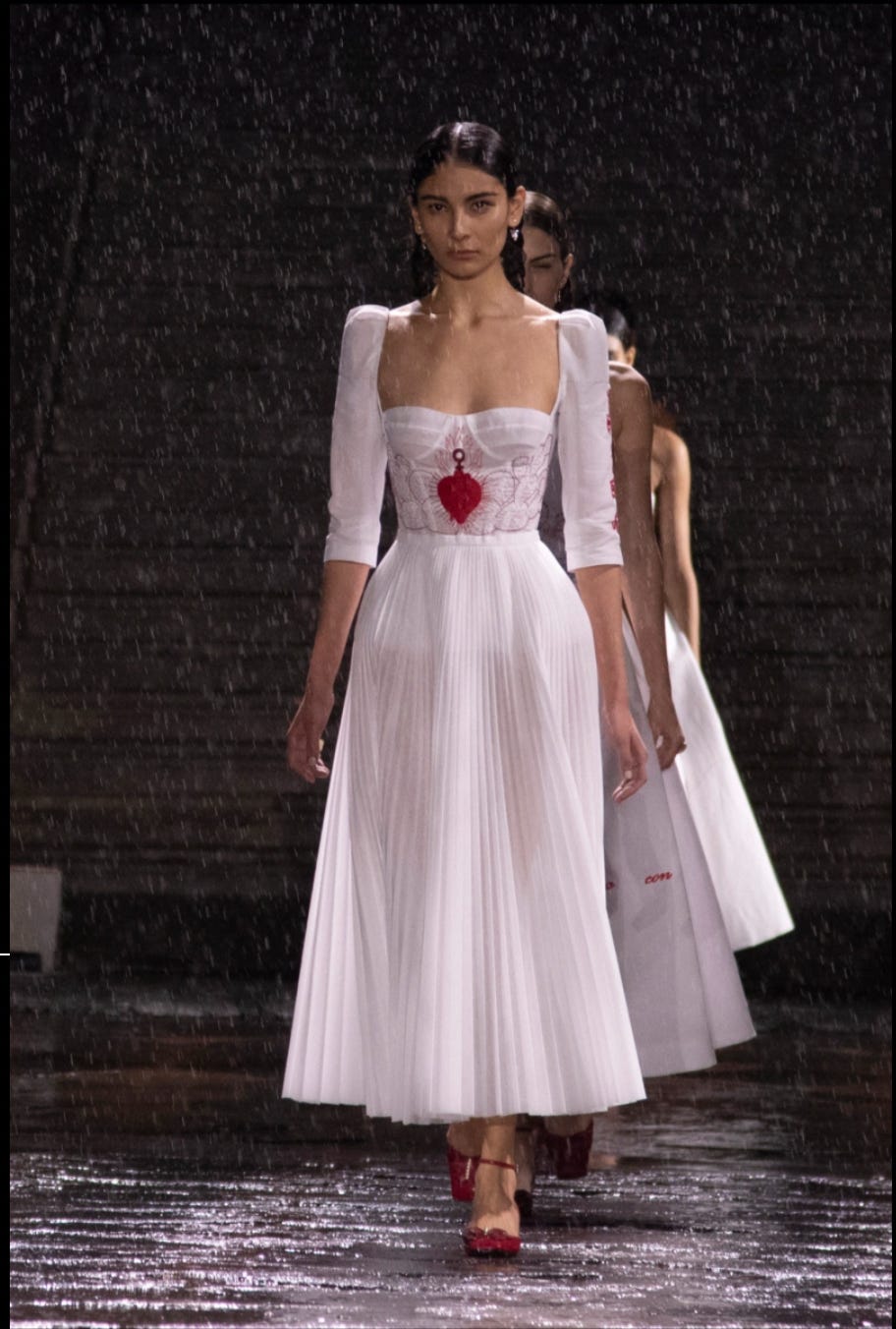
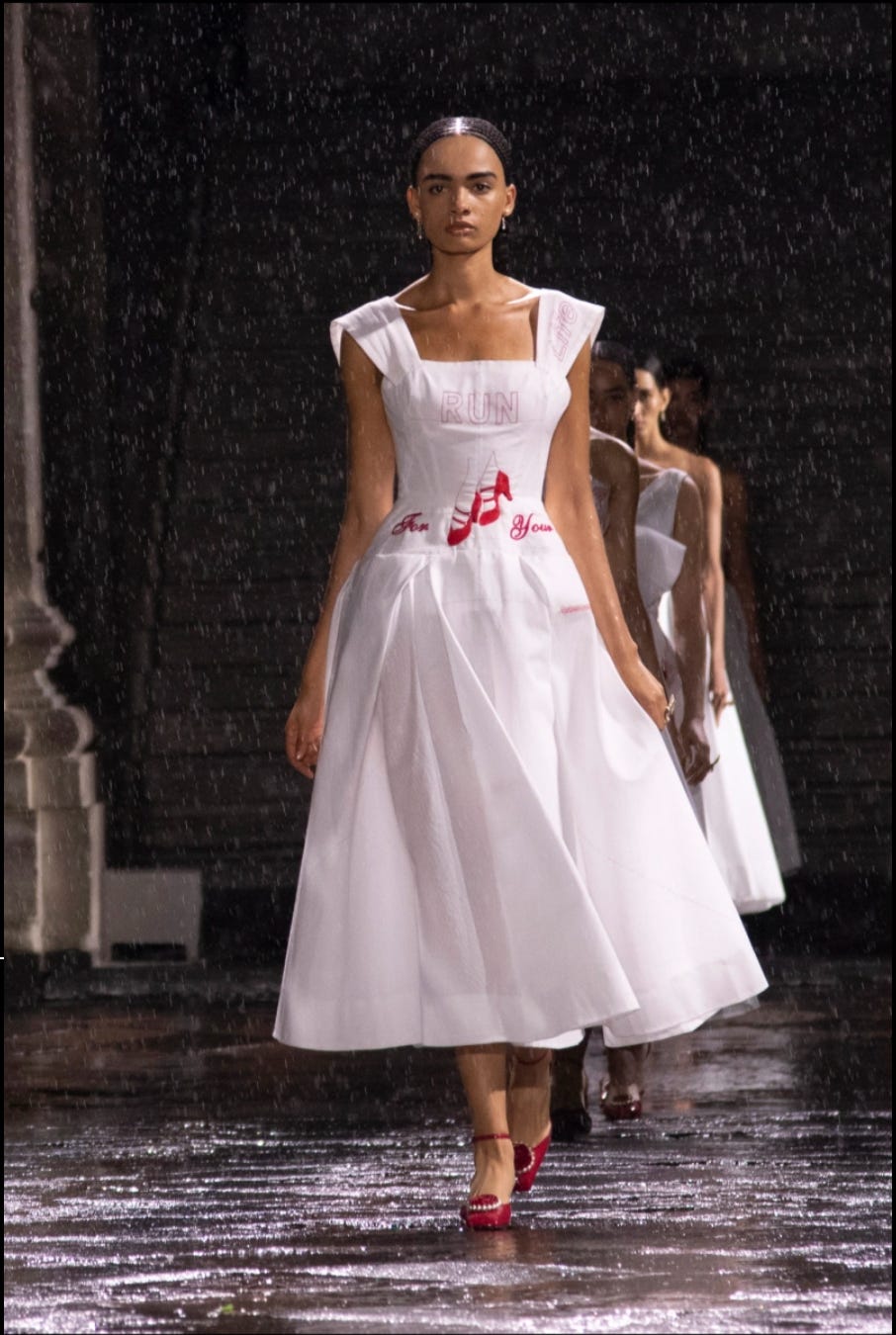


Concluding the show in breathtaking fashion, Elina Chauvet took center stage with a performance while wearing red shoes that drew inspiration from her renowned "Red Shoes" installations. This installation features an array of red shoes scattered across public spaces, serving as a symbol to raise awareness about the issue of femicide occurring in Mexico and the loss and heartache that is the outcome. Through her artistry, Chauvet sheds light on the pervasive nature of gendered violence.
This powerful theme resonated throughout the red embroidered designs on the re-imagined Dior white dresses. What a breathtaking conclusion to the show!

Unfortunately, major fashion companies and prominent designers frequently appropriate the work of underrepresented and marginalized communities, failing to acknowledge the artisans who created those ideas. Commendably, Dior gave underrepresented communities a platform to showcase their unique artistry in this show.
This beautifully executed show was a remarkable tribute to Mexican culture, with each look speaking volumes about the tremendous thought and innovation that was put into crafting each piece. Seamlessly blending traditional culture with contemporary fashion, the collection showcased a fusion of heritage and modernity.
Which other fashion companies or designers have you noticed that demonstrate a similar commitment to giving credit where it's due like Dior?
How often have you witnessed brands copy and paste culturally significant designs, without providing proper credit, just to make a profit?
It is time to make a change.
Final oversight & edits by Amarissa.
Itzel is a participant in Fashion Talk's Summer 23 Student Writing Program. Aligned with our mission to uplift young voices in the fashion industry, we’re excited to share her fresh and insightful perspective with our community.
Get to know Itzel here.


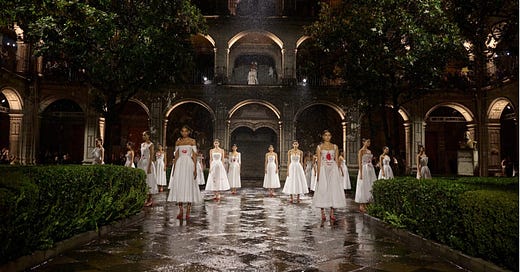





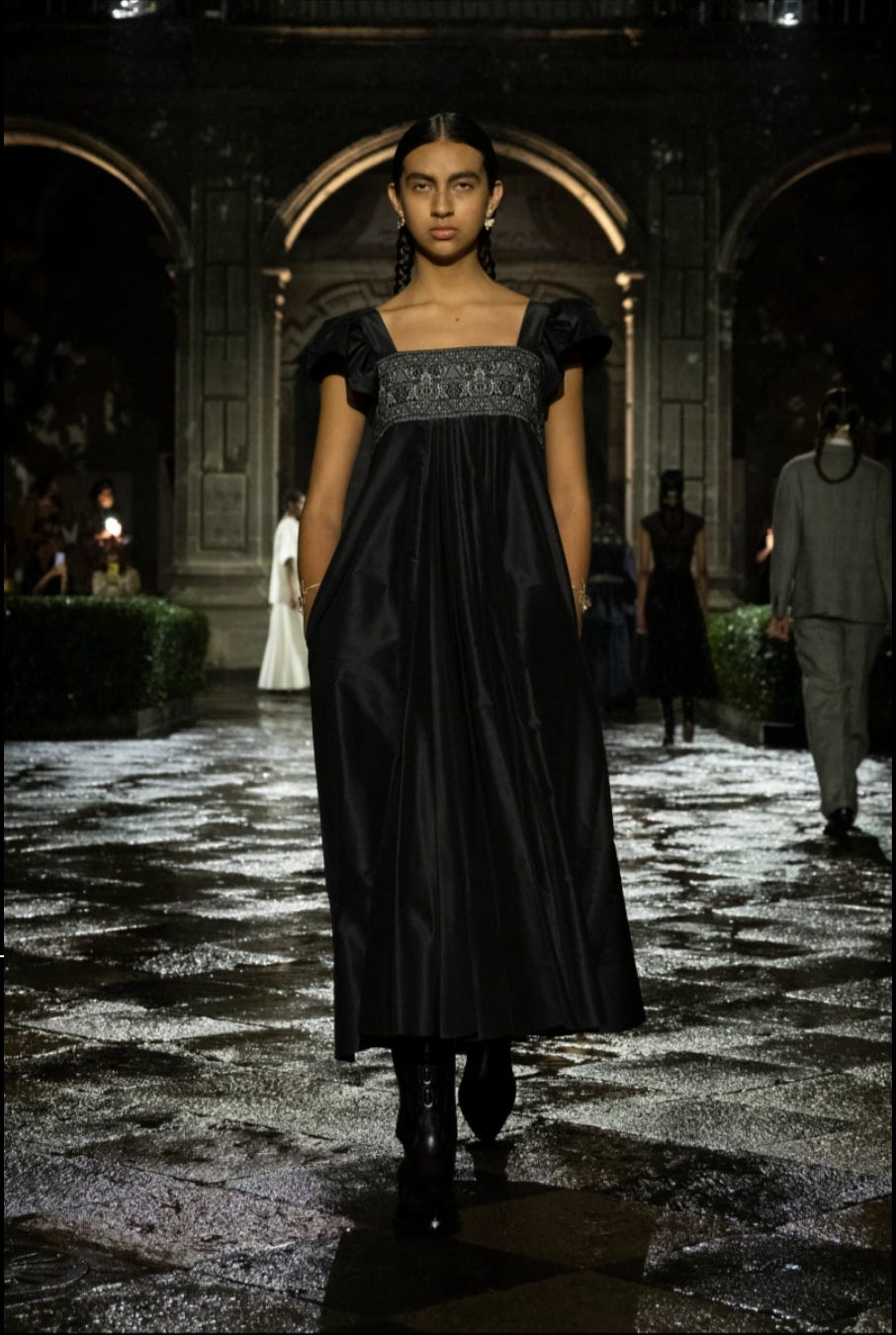


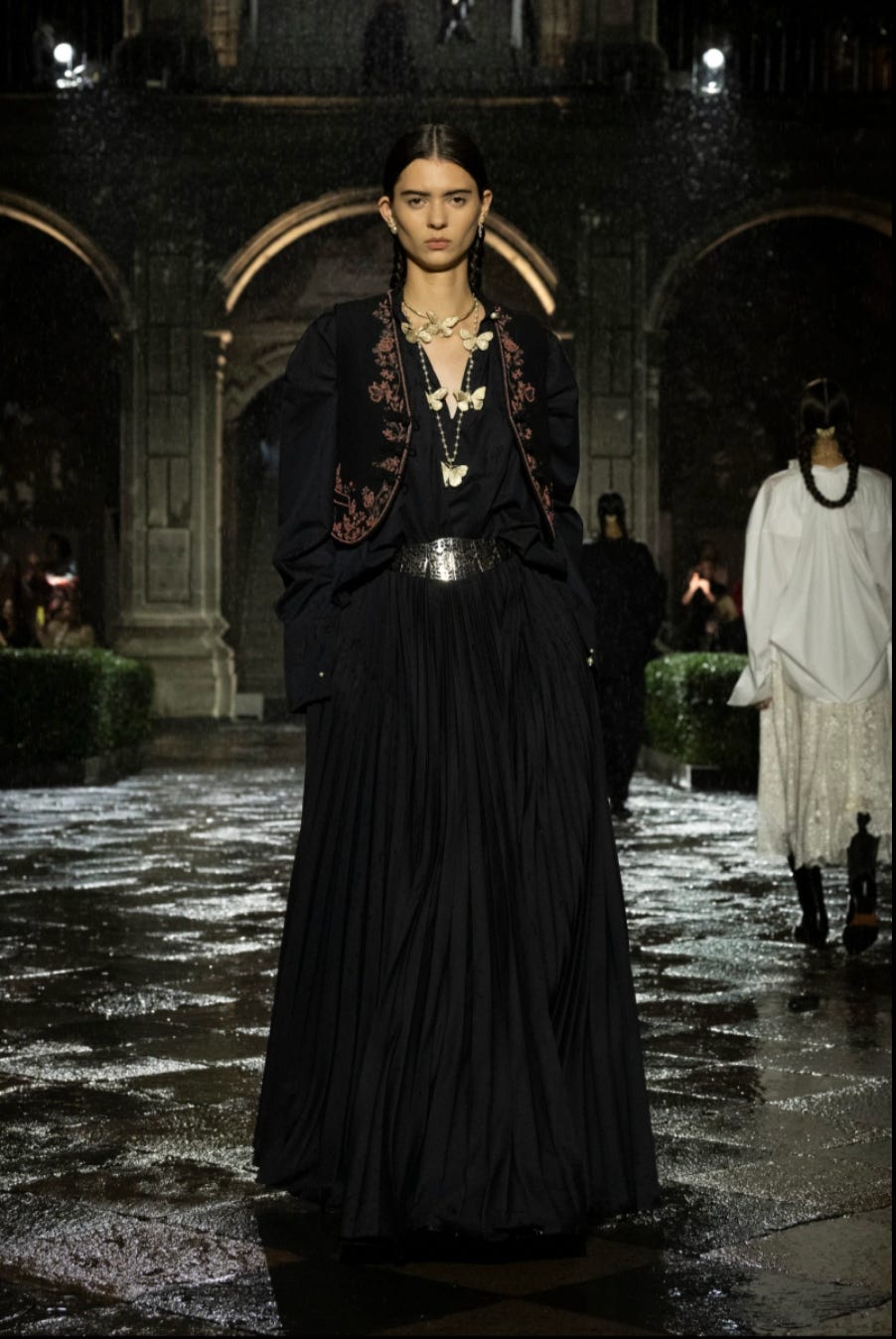











What a fantastic roundup of the Met Gala's best-dressed! This year's theme truly inspired some stunning and creative looks. I loved seeing how each celebrity interpreted the theme uniquely, especially [Favorite Celebrity]'s outfit which perfectly balanced elegance and avant-garde fashion. Your detailed descriptions and photos capture the essence of the event beautifully. Looking forward to more fashion highlights!
Fashion brands must do more to educate consumers. Packaging incentives, led by the likes of Puma are a drop in the ocean, and don't address decarbonisation. The construction industry is making progress towards transparency through externally verified Environmental Product Declarations. Let's hope the fashion industry follows the example being set by a huge carbon emitter.